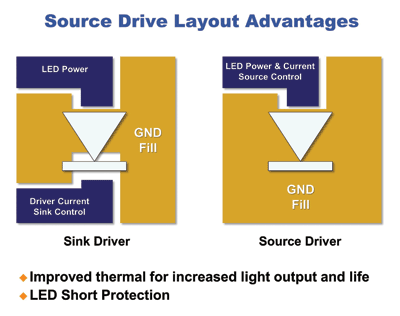Why LED shortcuts won’t work
BY DAN JACOBS,TT electronics OPTEK Technology, Carrollton, TX
http://www.optekinc.com
Most implementations of LEDs for general lighting currently involve tailoring them to fit existing socket form factors. As examples, there are LED “bulbs” to directly replace incandescent light bulbs in Edison screw sockets and LED “tubes” to directly replace fluorescent lamps in linear tube fixtures.
In each case, multiple subsystems are forced to coexist in nearly the same space — primarily optics, thermal management, and electronics — sacrificing the efficiency of each. Retaining old form factors provides upfront savings and allows direct retrofit with minimal effort, but doing so curtails LED performance and stigmatizes LED products as dim or unaesthetic.
http://www.nxtbook.com/nxtbooks/hearst/projectlighting_201102/index.php?startid=5


In targeted fixtures such as recessed cans (top) and troffers (bottom), the reflector and diffuser form an enclosure that captures heat and limits its dissipation from LEDs installed within the fixture.
Fundamentals of LED planar lighting
BY ITAI COHEN, Oree, Tel Aviv, Israel
http://www.oree-inc.com
As the quality and reliability of LEDs improves, their use is becoming more popular, as witnessed by a proliferation of LED applications for accent lighting, outdoor lighting, architectural fixtures, retail, and decorative fixtures. LEDs are opening new possibilities in lighting design, one of which is planar lighting, also known as area lighting.
LED planar lighting refers to the lighting of large, uniform surfaces using LEDs. These surfaces include illumination applications such as undercabinet lighting and ceiling-mounted fixtures, as well as luminance applications such as wall-mounted fixtures and marker lights.
http://www.nxtbook.com/nxtbooks/hearst/projectlighting_201102/index.php?startid=10

The most widely used approaches to planar light today are edge-lit (left) and back-lit (right).
Overcoming the design challenges using HB LEDs
BY JOSE RODRIGUEZ, Analog Devices, Norwood, MA
http://www.analog.com
Flash LED lighting in handsets has become an important aspect of the end-user experience, allowing the capture of images in low-lighting conditions. The need for assist lighting has also increased due to the use of higher-megapixel cameras, which tend to have lower performance in low-light conditions due to their higher pixel densities and smaller pixel size.
http://www.nxtbook.com/nxtbooks/hearst/projectlighting_201102/index.php?startid=15

Sink driver vs . source driver.
A system’s approach to SSL systems
Bringing a product based on new technology to market has always been risky. If there’s an unforeseen problem with it, the product can leave a bad taste in the public’s mouth for the technology, and even if a fix is found that makes the product superior to anything else in the marketplace, the damage that’s been done to the technology’s image may never be undone.
The technical approach to avoid this problem is known as systems engineering. In this approach, engineers don’t simply try to create a widget using new technology, but try to look at all the factors that impact how a product will be used, and base their design on meeting the potential customer’s stated, and unstated, requirements. It’s that kind of approach that has made products like the iPhone the huge success it is.
When it comes to solid state lighting, until recently the trend has been to not take a system’s approach. In general, companies have been offering individual components – LEDs, controllers, power supplies and letting their customer, the luminaire manufacturer, take on the task of getting all the pieces to work together. The success of the luminaire thus has depended on the degree to which the manufacturer understands the physics and engineering of SSL.
But that changed last month when Tyco Electronics (www.te.com) introduced the Nevalo SSL system. The company says that the system “combines the many new components and disciplines of SSL systems into one simple, coherent packaged solution” to provide both lighting-design flexibility, and high performance.
In essence, Nevalo is a family of products that includes LED modules (with outputs ranging from 300 to 3,400 lm), optics, thermal management devices, drivers, wiring systems, and lighting controls that are all keyed for easy integration. By having a broad variety of easily integrated components to choose from, the lighting designer is free to focus on his or her customer’s esthetic and lighting requirements; the electronic engineering is integrated into the component system.
I’ll bet that taking this systems engineering approach to SSL will prove successful; after all, history shows the odds are in my favor.
Richard Comerford
Advertisement
Learn more about Digi-Key





